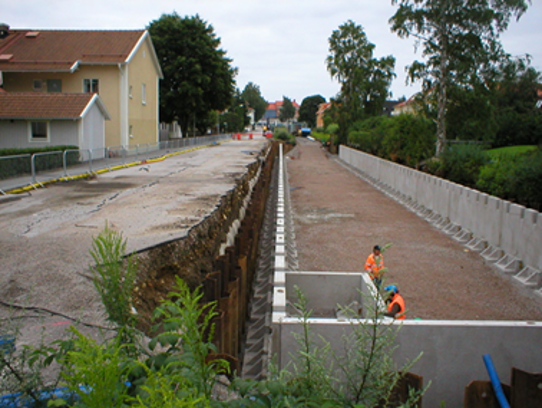The city slopes towards the south, which means that much of the water that falls on Växjö runs south and ends up in the surrounding lakes. In Växjö, there has long been a comprehensive approach to the problems of flooding and surface runoff. There is a desire to avoid standing water on hard surfaces that results in flooded houses and cellars. A number of storm water retention ponds have been built both over and under the ground. A storm water retention pond is a temporary pond for surface runoff.

The storm water retention ponds and their function
The concrete reservoir
In the central parts of Växjö, there are enclosed low thoroughfares from which surface water cannot escape and often flood during heavy rain. To solve this problem, a concrete reservoir was built under a parking surface. The concrete reservoir’s job is to relieve the pressure on the surface runoff drains. When the water has run out of the drains, the reservoir is emptied via a non-return valve and continues through the drainage network.
The football pond
A football pitch acts as a storm water retention pond in a residential area where there were problems with flooding. All the surface runoff that goes into the drains in the area runs along the football pitch. When the rate of flow in the surface runoff drains is high, the water is forced up onto the pitch, before then sinking back down when the drains are able to accept more water.
Financing
Växjö Municipality bore the cost of both storm water retention ponds. The concrete reservoir cost around SEK 1 350 000 and had a labour cost of approximately SEK 1 200 000. The cost of the football pond was around SEK 1 200 000, excluding the football goals and the stone walls.
More examples of climate adaptation
This is one of many examples of climate adaptation. There are more in the collection of ideas being built up by the Swedish National Knowledge Centre for Climate Change Adaptation at the Swedish Meteorological and Hydrological Institute (SMHI). The collection of examples has the aim of sharing experiences and providing ideas to everyone who works with climate adaptation. Examples describe concrete measures and challenges in several subject areas. They show how different actors have worked to adapt their activities to the climate changes that are already being noticed today and those that we cannot prevent in the future.